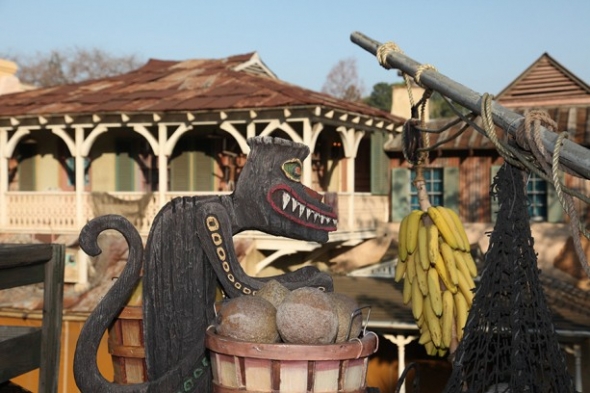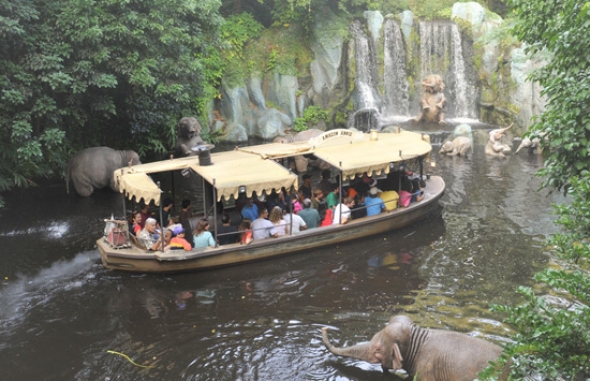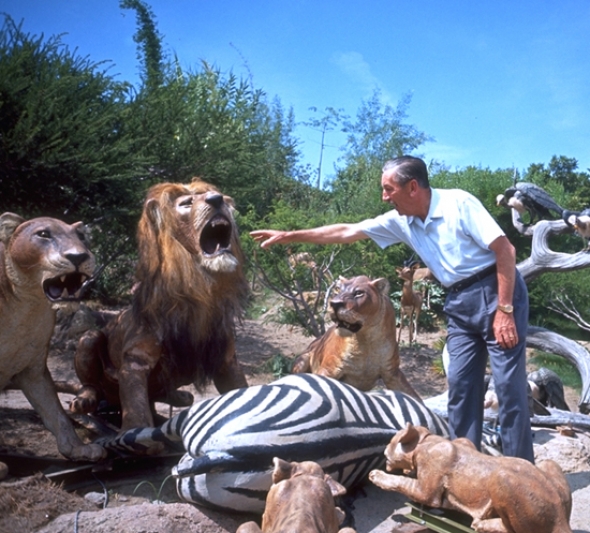“Could lead to treasure, could lead to certain doom! Keep your eyes wide open. I’m gonna keep mine closed.”
None of the park hubs proved more difficult than Adventureland, though. At its start, it would feature but one attraction, Jungle Cruise. Disney’s plans for the park included a strange combination of specificity and ambiguity. He famously looked at a stage near a waterfall in the area. Disney confidently stated, “I’d like to part the water and let the entertainers come out, and then have the waterfall close behind them.” Right on cue, Fowler replied, “Can do.” Whenever Disney knew what he wanted, his loyal employee did what he could.
The problem was that Disney didn’t know exactly what he wanted. His original idea for Jungle Cruise involved theme park visitors interacting with live animals. That was what he loved about The African Lion, after all. All of the animals shared the same living quarters. Disney desired that for his Jungle Cruise. He brought the idea to Harper Goff, who, unbeknownst to his boss, modified the plan to mimic one of the most popular movies of the day, 1951’s The African Queen, starring Humphrey Bogart and Katharine Hepburn. The American Film Institute consistently names this film one of the top 100 of all-time, but it was only two-and-a-half years old when developers broke ground on Disneyland on July 16, 1954.
Due to the timeliness of The African Queen, an imitation of the movie’s story of people sharing a riverboat adventure was a no-brainer except for one concern. Would a story vaguely similar to a 1951 movie maintain relevance over time?
Goff loved the movie and the attraction concept it had incepted so much that he ignored the potential downside. He presented his idea to Walt Disney. Jungle Cruise would provide a riverboat cruise experience to the public featuring all the animal interactions his boss expected. The captain of the ship would perform the roles of protector and narrator during the ride. They would pretend as if every second of the trip involved peril and, potentially, mortal danger. Along the way, they would also draw attention to the various animals strategically placed in plain sight of the Jungle Cruise riders.
The African Queen was the optimal premise to imitate if the attraction were to offer a true simulation of a journey into the wild. Goff knew that if they based the ride on a journey down the Suwannee River, the original watercourse model for Adventureland, it would bore park guests. If it were based in Africa, Jungle Cruise would cement the idea that a person entering Adventureland was truly entering a new place, an exotic land full of mystery and excitement…and really bad puns. But we’ll get to that.
There’s something you don’t see every day. Well, I do. Every 15 minutes.
The solution to the last problem generated a new concern. No matter how well trained Disney employees may become, nobody in the 1960s believed that they could provide a respectable jungle cruise experience in surroundings comprised of live animals. Yes, with the benefit of hindsight once again, we know that Disney’s 1990s Imagineers proved their 1950s predecessors wrong when they successfully launched Animal Kingdom in 1998. A lot can change in four decades. That doesn’t alter the fact that the 1950s park planners had cause for concern.
Live animals don’t keep to a human schedule. Anyone who has visited Kilimanjaro Safaris knows that even today, Disney-coached animals still eat, sleep, and be merry on their own time. The entire landscape has clusters of animals in order to guarantee that a person riding through the attraction will see at least some members of the menagerie. Also, the constant onslaught of humans traveling so nearby could cause cultural disruptions across the various species. Finally, many of the animals Walt Disney preferred were nocturnal by nature, and Disneyland wouldn’t stay open overnight.
Think about how difficult such challenges looked on paper in early 1954. Park designers couldn’t even guarantee that the animals would remain in their designated living quarters at a given time. Imagine the hysteria the occasional escaped animal would have created. The fear of planning a riverboat journey including a series of encounters with creatures in their (mostly) natural habitat kept Imagineers up at night.
Walt Disney acknowledged the point, but he came at the problem from a new point of view. From his perspective, a theme park should exist as an especially large film set. Almost all of his ideas for Disneyland were expansions of premises that Imagineers tested on Hollywood soundstages first. Many film productions used live animals to add a cuteness factor. Disney presumed that the concept would translate easily to his theme park. To argue his case, he noted that the giant squid his special effects team had created for the 1954 Disney release, 20,000 Leagues Under the Sea, was extremely life-like. He imagined that creatures such as crocodiles, elephants, and monkeys should prove easy for his team to bring to life.
The Imagineers refused to cede the point to their leader. They countered that lifelike animal caricatures would have one problem or another. They would either look so lifeless that they would negate the Jungle Cruise experience or they would need animatronics to appear living. The latter issue should have been a deal breaker, because there was no known way to hide the circuitry required to power animatronics. Plus, some of the wiring would need to go underwater, which isn’t a great idea when it comes to electricity.
Disney held his ground. He knew that director John Huston staged The African Queen in a way that the titular tramp steamer was never “totally clear of the water or the underbrush.” This became the blueprint for Jungle Cruise. If they cleverly placed the animals in the right spots, Imagineers could supply power to animatronics without the guests ever seeing the wiring. In this manner, they could protect the illusion of the riverboat adventure while making all the animals seem life-like. Of course, that’s become less important over time, but Disney demanded perfection during the early days of Disneyland.
Amusingly, the best laid plans still fell apart in the end. As you probably know, the complicated circuitry for the animatronics worked almost flawlessly from day one. Even before the attraction was open to the public, however, Disney’s staff knew they had a huge problem. The artificially colored water provided an accidental side effect. It coated all the animals in a slush that interrupted the spinning of basic cogs and wheels. Yes, all the complex solutions for the state-of-the-art animatronics worked great, but the basic machinery that had worked for centuries broke down.




Comments
"Ladies and gentlemen as you exit the boat please watch your step. If you don't, please watch your head. And if you won't watch your head please watch your language."